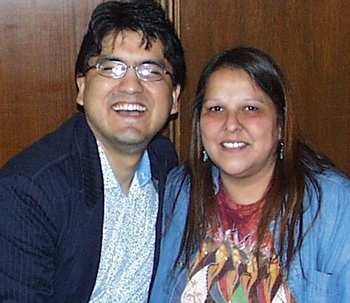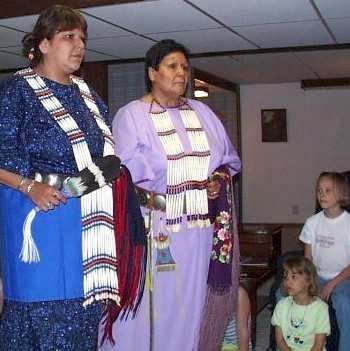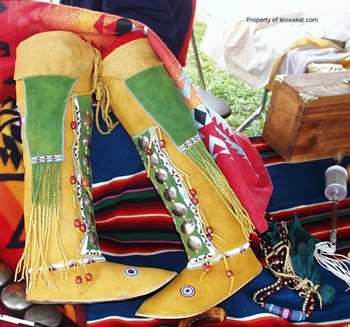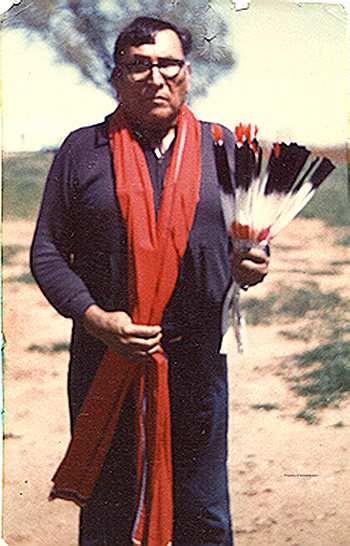Saynday, the Mythical Folk Hero of the Kiowa
 Hi, my name is Katherine Dickerson. My Kiowa name is Tah’Po-Mah – named after my great grandmother. I am a registered member of the Kiowa Tribe of Oklahoma. Haungooah, English translation Silverhorn. The Kiowa is located in the southwest part of Oklahoma with rocky rough terrain, rolling hills, windswept bluffs, and wide-open plains spread out from the Wichita mountains as far as the eye can see.
Hi, my name is Katherine Dickerson. My Kiowa name is Tah’Po-Mah – named after my great grandmother. I am a registered member of the Kiowa Tribe of Oklahoma. Haungooah, English translation Silverhorn. The Kiowa is located in the southwest part of Oklahoma with rocky rough terrain, rolling hills, windswept bluffs, and wide-open plains spread out from the Wichita mountains as far as the eye can see.
Silverhorn was noted by the Kiowa tribe as a master illustrator – an artist born in 1860. Silverhorn illustrated everyday life on the plains of the Kiowa. Whether it be sacred ceremonies, warfare, or telling the ever-popular Sayn Day stories. He was also preserving what was then by drawing illustrations. Silverhorn’s son, my grandpa, James Silverhorn, was also a master craftsman along with his brothers. James Silverhorn was also a religious leader of the Kiowa tribe. There’s a long line of artisans in the Silverhorn family.
 My aunts and uncles along with my parents, Paul and Phyllis Calcaterra Silverhorn, raised me to respect the Kiowa ways. I was a Kiowa woman who understand my place in the Kiowa tribe and I’m practicing these today. I grew up hearing, observing, and living the traditional Kiowa ways prompting me to create craftwork today that is identified as Kiowa pieces. To do this way as my elders did in the past to make the materials, brain tan hides, and use the sinew. These materials were essential for tipis and clothing like pants, shirts, dresses, footwear, bedding, and cradleboards. Ceremonial items and also made for calendar keeping and the list goes on. These ways must be passed down and passed to preserve and keep the identity of the Kiowa tribe. There are guidelines for the way these items were constructed and assembled that also identities the tribe.
My aunts and uncles along with my parents, Paul and Phyllis Calcaterra Silverhorn, raised me to respect the Kiowa ways. I was a Kiowa woman who understand my place in the Kiowa tribe and I’m practicing these today. I grew up hearing, observing, and living the traditional Kiowa ways prompting me to create craftwork today that is identified as Kiowa pieces. To do this way as my elders did in the past to make the materials, brain tan hides, and use the sinew. These materials were essential for tipis and clothing like pants, shirts, dresses, footwear, bedding, and cradleboards. Ceremonial items and also made for calendar keeping and the list goes on. These ways must be passed down and passed to preserve and keep the identity of the Kiowa tribe. There are guidelines for the way these items were constructed and assembled that also identities the tribe.
These items tell stories and have a history themselves. Each piece I make is for a reason. Example; why where, when, and how these items were worn throughout daily life on the plains.
As a child, numerous Saynday stories were told at family gatherings. Saynday is the mythical folk hero of the Kiowa. The stories tell of how the Kiowa came to be. My favorite Saynday story is how Saynday silenced the dogs.
 These stories are for the young and the elders. They were told from generation to generation. Saynday was coming along a trail that led him to a noisy village where everyone was talking at the same time. He thought his expected entry might temporarily silence the people. But when he walked into the camp everyone ignored him and remained as noisy as before. As he looked around Saynday saw that inhabitants of the village were dogs. The father dogs were yelling at the mother dogs. The mother dogs were yelling at the puppy dogs and the puppy dogs were yelling at Saynday. The longer he stood there the louder the dogs yelled. Finally, Saynday could stand the noise no longer.
These stories are for the young and the elders. They were told from generation to generation. Saynday was coming along a trail that led him to a noisy village where everyone was talking at the same time. He thought his expected entry might temporarily silence the people. But when he walked into the camp everyone ignored him and remained as noisy as before. As he looked around Saynday saw that inhabitants of the village were dogs. The father dogs were yelling at the mother dogs. The mother dogs were yelling at the puppy dogs and the puppy dogs were yelling at Saynday. The longer he stood there the louder the dogs yelled. Finally, Saynday could stand the noise no longer.
Silence Saynday shouted. I have come to visit you and I wish to say something. The dogs ignored his command and continued talking loudly. Four times Saynday ordered the dogs to be quiet. Four times the dogs growled at him and continued the noisy talking. The final time Saynday angrily warned them that something bad could happen if they don’t remain silent. The dogs continued talking and Saynday pulled out his medicine bag of power. You would not become silent and listen to what I have to say declared Saynday. Four times I’ve asked you to be quiet and the last time I warned you. Now it’s too late. From this day forward you will not be able to say a single word. Never again will you talk to your mothers or fathers. Your mothers and fathers will be able only to growl and bark and the puppies will only be able to yap. When they wish to say something other people will not be able to understand you. From now on you can talk to other people only your eyes and tails. That is why dogs today do not talk but must communicate with their eyes and tails.
Katherine Dickerson
Katherine Dickerson is a member of the Kiowa Tribe in Oklahoma. Some of her lineages go back to her great grandfather, Haungooah Silverhorn, who was famous for ledger drawings. She is also a descendant of Tongkeahma and Stumbling Bear. Dohausan, Haungooah’s father was the principal chief of the Kiowa tribe. Her Grandpa, James Silverhorn, was also a craftsman. His brother, Dutch Silverhorn was a famous silversmith. Her great uncle Max Silverhorn was noted for beading and featherwork. The Kiowa migrated from the northern plains around the Yellowstone River and Missouri River down to the southwest part of Oklahoma. The terrain is rocky, with rolling hills, windswept bluffs, and wide-open plains.
Kathy was raised going between St. Louis and her tribal lands in Oklahoma and has spent her entire life learning the crafts, culture, and history of her tribe from elders and her father (Paul Calcaterra,
master craftsman and a historian of the Southern Indian Plains Indians).
Depending on the age of the audience and venue Kathy shares history, storytelling, tribal song, and dance, and her craftsmanship. She uses the hands-on approach most often with children. She makes materials the way they were made back in the 1800s. She scrapes her hides and brain tans them. The bags, belts, beaded fans, beaded gourds, and footwear that Kathy makes are used in her presentations. For example, she tells about the belt bag, like a utility bag, that women wore around the campsite. They used the belt bag to carry all items used for the campsite and fire-making. It saved them from having to make numerous trips back to the tipi.
 The beginning of the tribe starts with the mythical folk hero, Saynday, and how he was coming along. Saynday was coming along in the darkness upon the face of the sunless earth. He was both lonely and curious and he wondered about the world without people and animals. Stumbling along he stretched out his arms and felt something, carefully probing it with his hands and fingers he recognized the rough surface of the cottonwood tree. Tired and discouraged Saynday stopped to rest and as he relaxed he heard a strange sound come from beneath the hollow cottonwood tree. Wrapping on it he called out, “Who’s there? Who is it? Who are you?” All of sudden he heard, “We are the people. We want to come out into your world. Help us. Come and answer.” Excited, Saynday reached through a hole in the tree into the underground darkness. Holding out his hand he clasped the hand of another person nearest him and instructed everyone else to do the same thus forming a chain of people coming out of the hole. He pulled the first person out of the hole in the trunk made by an owl. He watched in amazement as they poured out like ants. After so many emerged a pregnant female became stuck in the hole and couldn’t go forward or backward and blocked the way for those behind her. No more came out. Those who made it out gathered with Saynday. Bending down and smiling he said his name and as a friend and was happy to see them. He told them he would teach them how to live in this world, find food to eat, and how to be happy. He said he would be their uncle Saynday and they will be his people. Those who came out were known as the Kiowas. Because the pregnant female kept all the people from coming out into the world, the Kiowa has always been a small tribe and that’s why we’re a small tribe today.
The beginning of the tribe starts with the mythical folk hero, Saynday, and how he was coming along. Saynday was coming along in the darkness upon the face of the sunless earth. He was both lonely and curious and he wondered about the world without people and animals. Stumbling along he stretched out his arms and felt something, carefully probing it with his hands and fingers he recognized the rough surface of the cottonwood tree. Tired and discouraged Saynday stopped to rest and as he relaxed he heard a strange sound come from beneath the hollow cottonwood tree. Wrapping on it he called out, “Who’s there? Who is it? Who are you?” All of sudden he heard, “We are the people. We want to come out into your world. Help us. Come and answer.” Excited, Saynday reached through a hole in the tree into the underground darkness. Holding out his hand he clasped the hand of another person nearest him and instructed everyone else to do the same thus forming a chain of people coming out of the hole. He pulled the first person out of the hole in the trunk made by an owl. He watched in amazement as they poured out like ants. After so many emerged a pregnant female became stuck in the hole and couldn’t go forward or backward and blocked the way for those behind her. No more came out. Those who made it out gathered with Saynday. Bending down and smiling he said his name and as a friend and was happy to see them. He told them he would teach them how to live in this world, find food to eat, and how to be happy. He said he would be their uncle Saynday and they will be his people. Those who came out were known as the Kiowas. Because the pregnant female kept all the people from coming out into the world, the Kiowa has always been a small tribe and that’s why we’re a small tribe today.
When showing regalia Kathy can explain the different kinds of items that are used with the dances that are performed at pow wows; dances such as the rabbit dance, the Kiowa gourd dance, the round dance, the regular war dance, and the veterans dance.
In her upbringing, she was surrounded by cultural awareness and is expected to carry on the ways of her ancestors. Her particular art form is unique, not all due to her ability as it is to decide. Her decision was not to follow the modern pow-wow styles but to stay true to my Kiowa traditional craftwork. Using sinew or sometimes cloth thread (both were used in the 1800s) she is able to bring a little of the glorious past to the present day. Her work is as exact and as traditional as she knows how to do it.
Kathy enjoys keeping the Kiowa traditions alive and has been giving demonstrations and lectures in school and other gatherings ever since she was in grade school herself.
Kathy has demonstrated for:
- National Museum of the American Indian in Washington, DC.
- Cahokia Mounds Museum in Illinois for their Rediscover days
- Our Lady on the Snows Shrine Cultural Festivals
- Daniel Boone Home of Defiance MO
- Monsanto Chemical Company/daycare children with employees
- Boy scouts of America/ Girl scouts troops
- Deaconess College of Nursing
- Washington University
- Son of the Confederate Veterans
- Township Festivals such as Wildwood, Warson Woods, Maplewood, Fenton,
- Wentzville MO, St.Louis and St. Louis Country MO fairs.
- Rockwood school district
- St. Louis City School District
- Wentzville school district
- Union Mo School District
- She’ll be on exhibit at the opening of the Oklahoma History Museum November 13-20, 2005.
- She was also Secretary of the Board of the American Indian Center of St. Louis, 2002-2003.
- She placed at the Matoon Illinois crafts contest for beadwork.
Katherine Dickerson
3470 Macklind Ave.
St. Louis, Missouri 63139
314-283-7763
Kathy@kiowakat.com
www.kiowakat.com
